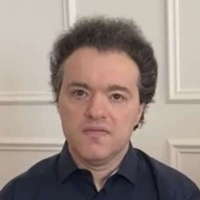 LISTENING TO TCHAIKOVSKY: Béla Hartmann uses his knowledge of Eastern Europe to argue against the banning of all Russian culture following Vladimir Putin's invasion of Ukraine.
LISTENING TO TCHAIKOVSKY: Béla Hartmann uses his knowledge of Eastern Europe to argue against the banning of all Russian culture following Vladimir Putin's invasion of Ukraine.
AN ELITIST DANCE?

GEORGE COLERICK writes about the tango
During the decades when ballroom dancing was dominant, in Britain the tango was widely regarded with awe, the superior dance, the 'difficult one'. Following the waltz, fox-trot and quick-step, it would be introduced to classes alongside the rumba, flamboyant but less formidable. The first tango routine is unusual, partly because one does not face the partner full on but diagonally whilst the hips are generally the closest area of contact, with freer movement elsewhere. The basic rhythm is very deliberate, and though the steps are slow, quick, quick, slow, quick, quick, slow, the rhythm is very different from the waltz's. The one feature they had in common is that they were almost the first to be recognised as permitting the male to place his arm around the partner's waist.

An Argentinian tango being danced in the streets of San Telmo, Buenos Aires in 2004. Photo: Anouchka Unel (Free Art Licence)
For the British, the most familiar tangos have been heard in Jealousy and La Cumparsita with their assertive rhythms and theatrical in a Latin way, very elaborate. Less able dancers tended to withdraw from it, leaving the field for the most skilled. The tango became elitist, very prominent in British dance hall competitions. A less daunting option, also very artistic and of a similar speed was the slow foxtrot, because it gave similar options subtly to vary the pace. A main attraction is its unique glide, though curiously it had developed from the original, jerky foxtrot which has long since disappeared, with its unnecessary arm movements. An intriguing feature of the foxtrot is that one does not step on the beat.
The tango we knew had features in common with other ballroom dances. Its 'head click' was an invention which may have started in imitation of a Spanish style, but was not used in Latin America. Not everyone realised at first that the ballroom tango was so far from the 'authentic' Latin dance. It held sway for a long time, though it is less danced in one evening than other items in British ballrooms. In recent years, learners have increasingly opted for the original Argentinian dance, and we are most likely to see it on TV in its native setting.

El tango - a 1913 oil on cardboard painting by Rafael Barradas (1890-1929)
The habanera originated in Cuba and is best known as the one from Carmen. Its rhythm influenced the original tango which was being danced by the poor in the dives of Buenos Aires and Montevideo by 1900. In South America, these events took place in crowded rooms, the upper parts of the bodies remaining close, so suggesting the possessiveness of the male. Experts however state that it is sensual but not sexual in spirit.

A tango postcard from 1920
The basic step is not slow-quick but suggests the creep, seeming slow, leisurely by European standards. The partners may describe differing patterns, the female very mobile, moving elegantly around the male, their legs briefly intertwined. Casual dancing partners are not the way forward; there is every suggestion that intense preparation is desirable.
The tango was among the early twentieth century dances which began to edge out the traditional waltz and it rapidly became fashionable especially at parties for the rich in Europe. By the 1920s it entered operetta and musicals, and to our times enjoys its high musical reputation internationally.

A 1913 newspaper statement in German, banning 'wiggling and shifting dances'. The comment in the English-speaking world that 'dancing is a vertical expression of horizontal desire' can possibly be attributed to George Bernard Shaw.
There are many institutions to maintain its status and encourage innovation. In the Argentine, it is often played by 'classical' musicians, normally a minimal combination of piano, bandoneon and double bass, and as such a form of chamber music. The bandoneon, an instrument not unlike the concertina in appearance, gives a distinctive flavour to the music. Some of the melodies, like those of other Latin dances, are becoming popular in Europe; they had not been so commercialised as many for the ballroom tango, but the dance's intricate appeal is drawing increasing numbers to attend classes.
In the Argentine there has been a succession of influential participants. Carlos Gardel was probably his country's most admired personality at his untimely death in a plane crash, 1935.

A 1923 photograph by José María Silva of Carlos Gardel in a gaucho outfit
The classic period lasted for three more decades, but because it was very nationalist in sentiment, it was suppressed during the political dictatorships, which instead encouraged pop music inspired from abroad. After democracy was restored in 1983, the tango regained great favour at home and increasingly abroad.

A photograph by Pupeto Mastropasqua of Astor Piazzolla in 1971, leaning on his bandoneon. Piazzolla created a nuevo tango which incorporated elements of jazz, extended harmonies, dissonance, counterpoint and complex musical forms.
Into our time, it has inspired creativity with such exponents as Astor Piazzolla (1921-1992) who started as a bandoneon player and progressed, also with related compositions for the concert halls.
London UK

FURTHER INFORMATION ABOUT ASTOR PIAZZOLLA


